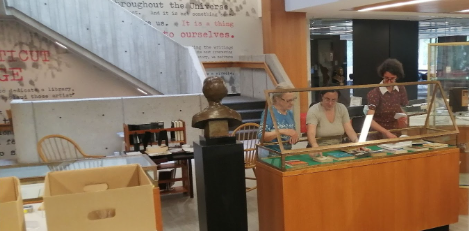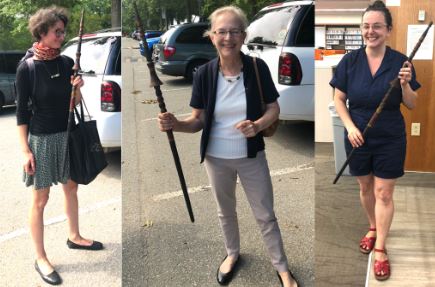Inspired by the Book is a series of interviews with Connecticut College folks about their literary lives. Inspiration comes from The New York Times Book Review series called By the Book.

Tereza Hadravová (TH) teaches aesthetics at Charles University in Prague. In 2021/2022, she was a Fulbright-Masaryk scholar at Connecticut College, where she studied the philosophy of Susanne K. Langer (1895 – 1985). She initiated an exhibition “Susanne K. Langer. A Kaleidoscope of Ideas”, currently on view at the Shain Library, that she co-curated with Carolyn Bergonzo and Linda Legassie.
Carolyn Bergonzo (CB) is a writer based in Watertown, MA. She holds an MFA in Literary Arts from Brown University, and is at work on various projects about women, thinking, and writing.
Linda Legassie (LL) teaches art history at Three Rivers Community College in Norwich, CT. She is the business manager for her family-owned business, Stepping Stones Antiques LLC, in Old Saybrook, CT. She was Susanne K. Langer’s research assistant from 1978 to 1985 participating in all aspects of the publication of Langer’s ninth book, Mind: An Essay on Human Feeling.

What books are on your night stand?
(TH) I do not have a night stand! I usually put the books that I am reading at night under my pillow and sleep on them. That limits the number of them and prioritizes soft covers. At the moment, there is Beloved by Toni Morrison under my pillow.
(CB) Jonathan Rée’s Witcraft: The Invention of Philosophy in English and Sina Queyras’s Rooms: Women, Writing, Woolf.
What’s the last great book you read?
(TH) JM Coetzee’s books have been long on my list, but I started reading them only a year ago. I found the first book I read – Waiting for the Barbarians – at a free books shelf at DuBois Beach in Stonington Burrough and was immediately “caught”. I bought some other ones – Disgrace, the Jesus trilogy, Elizabeth Costello – shortly after, also at a memorable place, at the Book Barn in East Lyme. I am fond of Coetzee’s complex provocations. The combination of a strong narrative voice and philosophical reflections is somewhat similar to Milan Kundera, a famous Czech-French author who I read enthusiastically when I was a young adult, right before I decided to study philosophy.
Whom do you consider the best writers—novelists, essayists, critics, memoirists, poets—working today?
(CB) Lisa Robertson. She has done it all, fearlessly, and with such an intoxicating style. I’m excited to read her recent project on Simone Weil, Anemones.
Was there a book that particularly inspired you?
(TH) Philosophy in a New Key by Susanne K. Langer was the book that I came across relatively late in my being a “professional” philosopher. I was finishing my dissertation in which I wrote about recent empirical aesthetics – neuroaesthetics and experimental aesthetics – and tried to see in which respect the findings made in the field would be relevant for traditional philosophical aesthetic topics, mainly those related to the question of aesthetic judgment. It seemed to me that the experiments run in laboratories were poorly designed and usually based on some more or less idiosyncratic and underdeveloped notion of aesthetic judgment of the experimenter. I was, however, also skeptical regarding the way some professional aestheticians treated scientific experimentation and the sciences in general as, by their very nature, an inappropriate field for philosophers.
Discovering Langer was a mind-blowing experience. I consider the way she incorporated scientific findings into her philosophical essays – critically, but also knowledgeably, with palpable curiosity – as a paradigm for current philosophers who wish to philosophize from a naturalists’ point of view. They are much more numerous nowadays than they used to be in Langer’s times!
(LL) After Mind vol. III went to press, I realized I wanted to return to college to study. In 1992, I attained the Master of Arts in Liberal Studies, inter-field major art and anthropology, from Wesleyan University, Middletown, CT.
Was there an author who particularly inspired you?
(CB) I’m inspired by Susanne Langer’s far-ranging intellect, her ability to synthesize knowledge across disciplines, and her lucid and lyrical writing style. I stumbled on Feeling and Form in a used bookshop in Vancouver over a decade ago and was transfixed by her ability to describe the creative process in a way that reflected my own experience as a young poet. Until that point, I had only encountered philosophers concerned with beauty in art. Langer attends to what motivates humans to make art in the first place, which is endlessly more interesting to me.
What books do you find yourself returning to again and again?
(CB) A book by another philosopher I admire, Anne Dufourmantelle: In Praise of Risk. I try to keep this book physically close to me at all times. It is a guide to expansive living and to opening up to the possibility of transformation.
Which childhood books and authors stick with you most?
(LL) The Amelia Bedelia books by Peggy Parish are stories of silly mix-ups that are wonderful proof of the power of language and gentle reminders of saying what you mean and meaning what you say.
What’s the last book you read that made you laugh? The last book you read that made you cry? The last book you read that made you furious?
(LL) The last book I read that made me laugh was Extra Virgin: A Young Woman Discovers the Italian Riviera, Where Every Month is Enchanted by Annie Hawes. This story is the biographical adventure of two English sisters who move (seasonally) to the Italian Riviera, (the other Riviera, not the Riviera they thought it was) at first to grow roses to sell at the English market, and learn all about olive culture while restoring their newly-acquired antique Italian farmhouse.
Leave a Reply